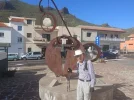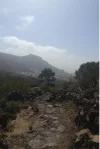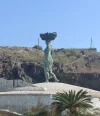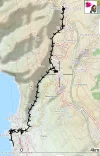HJDM
New Member
- Time of past OR future Camino
- Camino Frances and Norte on 2-way cycle Summer 2016
Camino de Gran Canaria Feb 2019
There is one - the Camino de Santiago del Tiede
During a recent walking holiday in Tenerife, using a Viewranger map for navigation, it was a pleasant surprise to find a walking route designated Camino del Santiago. What peregrino could resist?
Although last year’s three-day camino on Gran Canary (https://www.caminodesantiago.me/community/threads/camino-de-santiago-de-gran-canaria.60435/) was a recognised route, this one does not have any papal endorsement, nor was there any Compostela. That route can be completed during a leisurely day although the possibility of a longer walk across Tenerife exists.
Santiago de Teide is a village in the west of the island at 930m above sea level. It is about 8km inland and connected to Puerto de Santiago by a former trade route, now the Camino. Although there is a Santiago cross, scallop shell and gourd in an art work the town, the adjacent church is dedicated to San Fernando Rey and no compostellae are available there. This was more than compensated by live organ music on a sunny Saturday morning in February.
The route is attractive and appropriate to any Camino, it is a medieval path. It is for the large part downhill and midway, a short detour to the town of Tamaimo for lunch is hard to resist. The local food and beer in Arepera Girasol were excellent before continuing through current and former banana plantations to the port.
Obviously, the route was a trade link and it is recognised as a Camino Real (Royal Route). The traders were the girls and women of the Puerto who carried fish up to Santiago del Teide, then agricultural produce back down to the port. Presumably the men were fishing, farming, or discussing important matters. Fully laden each way, these girls ascended and descended approximately 1000m; anyone who is a Munro bagger in Scotland will appreciate the effort required. In recognition, there is a statue at a roundabout in the port.
The tourist information centre in Santiago del Teide had no information on the walk but an internet search shows several longer routes. It appears that for about 25 years, the Town Council of Santiago del Teide have organised an annual two day walk from Iglesia de Santiago Apostol in Los Realejos to arrive on 25th July. The start point marks where nine kings of the native Guanche converted to Christianity on St James’ day in 1496.
There is also an option to begin in the north of the island at Santa Cruz walking to Puerto de Santiago via Los Realejos and Santiago del Teide. It could be completed in three arduous days; five for someone of average fitness. Throughout the island, there are many ancient pathways and an excellent bus service although no pilgrim albergues.
Although not a “real” Camino, it is dedicated to Santiago and honoured by locals. IMHO it is much more attractive than the coastal tourist hot spots.




During a recent walking holiday in Tenerife, using a Viewranger map for navigation, it was a pleasant surprise to find a walking route designated Camino del Santiago. What peregrino could resist?
Although last year’s three-day camino on Gran Canary (https://www.caminodesantiago.me/community/threads/camino-de-santiago-de-gran-canaria.60435/) was a recognised route, this one does not have any papal endorsement, nor was there any Compostela. That route can be completed during a leisurely day although the possibility of a longer walk across Tenerife exists.
Santiago de Teide is a village in the west of the island at 930m above sea level. It is about 8km inland and connected to Puerto de Santiago by a former trade route, now the Camino. Although there is a Santiago cross, scallop shell and gourd in an art work the town, the adjacent church is dedicated to San Fernando Rey and no compostellae are available there. This was more than compensated by live organ music on a sunny Saturday morning in February.
The route is attractive and appropriate to any Camino, it is a medieval path. It is for the large part downhill and midway, a short detour to the town of Tamaimo for lunch is hard to resist. The local food and beer in Arepera Girasol were excellent before continuing through current and former banana plantations to the port.
Obviously, the route was a trade link and it is recognised as a Camino Real (Royal Route). The traders were the girls and women of the Puerto who carried fish up to Santiago del Teide, then agricultural produce back down to the port. Presumably the men were fishing, farming, or discussing important matters. Fully laden each way, these girls ascended and descended approximately 1000m; anyone who is a Munro bagger in Scotland will appreciate the effort required. In recognition, there is a statue at a roundabout in the port.
The tourist information centre in Santiago del Teide had no information on the walk but an internet search shows several longer routes. It appears that for about 25 years, the Town Council of Santiago del Teide have organised an annual two day walk from Iglesia de Santiago Apostol in Los Realejos to arrive on 25th July. The start point marks where nine kings of the native Guanche converted to Christianity on St James’ day in 1496.
There is also an option to begin in the north of the island at Santa Cruz walking to Puerto de Santiago via Los Realejos and Santiago del Teide. It could be completed in three arduous days; five for someone of average fitness. Throughout the island, there are many ancient pathways and an excellent bus service although no pilgrim albergues.
Although not a “real” Camino, it is dedicated to Santiago and honoured by locals. IMHO it is much more attractive than the coastal tourist hot spots.




Last edited:












